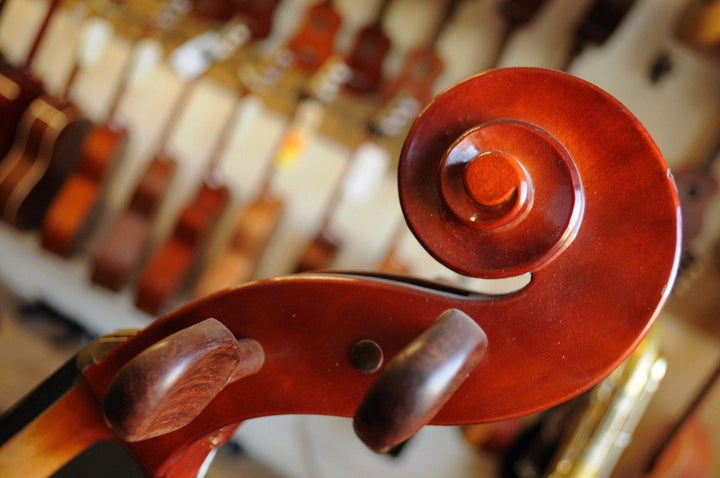
So often, we hear that music education is being cut away in American schools, leaving our children without the preparation to play instruments, to listen creatively, to sing or read music or write it. Usually this lament is slapped against a magical, perhaps mythical, memory of a past when, as we adults like to say, we all had music teachers. And piano lessons. Band or chorus. Concert tickets. Instruments. I have certainly lamented along with everyone else, worrying about the aging of audiences and wondering whether youngsters know anything about music today. But I have recently begun to re-think this lament, because, looking more closely, I am finding so many communities, so many classrooms and concert halls, where kids are coming together to make music.
For example, according to a survey by the National Center for Education Statistics, in 2009-2010 94 percent of American elementary schools and 91 percent of our secondary schools offered music instruction. Almost all employed specialized music teachers with full-time teaching loads. By contrast, only 4 percent of elementary schools and 45 percent of secondary schools offered theater, and even the visual arts are less available in our schools than is music. There are certainly many questions to be raised about these numbers: How rousing, or how resonant, is this instruction? How many children does it reach? How is it reinforced in home and community? But the mere fact of the figures is heartening; music does live in the schools.
I am also discovering music everywhere else. For American youngsters, music is alive and loud outside of school. The commitment to playing and singing and concertizing takes many forms. For instance:
- The League of American Orchestras reports that there are 500 youth orchestras in the U.S. The players range in age from 6 to 18; they give an average of seven concerts a year; many of the groups tour. Most of them collaborate with adult orchestras and other performing groups. They have boards and subscribers and funders; they are economically well-managed, and they have great community (and parent) support.
- A growing music movement in the U.S, El Sistema is a Venezuelan-born music education system that uses ensembles to change the lives of poor children. In Venezuela, it teaches music to 300,000 children -- lifting experience, aspiration and possibilities. In the U.S, there are now more than 40 El Sisetema programs in a growing network, locally inspired and locally led. The commitments to community and to poor children persist; the music is grounded in places like Durham, North Carolina; Fayetteville, New York; Avon, Colorado; Dorchester, Massachusetts; Wankwesha, Wisconsin, Bainbridge Island, Washington, often affiliated with Title One schools.
- The Young People's Chorus of New York City (YPC) includes 1,300 children aged seven to eighteen in its after-school programs, which present concerts in the city and beyond, hold residencies at Jazz at Lincoln Center and at New York Public Radio, sponsor regular lessons, rehearsals and projects. YPC has also commissioned over 60 works for children's voices by living composers, from David del Tredici to Meredith Monk. Children's singing together is not an isolated phenomenon, moreover. According to Chorus America, the national association for singing groups, 10 million children sing in choruses across the country.
I am also heartened by some things that may lie ahead. Gerard Schwarz, the much-honored artistic director of the Seattle Symphony Orchestra, retired from that job last June. Of course he will continue making music, both as a conductor and as a composer. But he also has a plan to develop a major television/DVD project that will put music into American homes, specifically benefiting the children in them. Gerry's project will present great musicians playing great pieces of music, with the kinds of introductions that will help make them beloved, like fireplaces or ice cream or pets, to American families. Music education was a priority of Gerry's time in Seattle, and the fact that he may take his talent for teaching to TV is very exciting. Like the San Francisco Opera on the internet, like New York's PS 22 chorus on YouTube, like big screen live performance in parks and on plazas, Gerry will be using popular technology to make music more public and more immediate to kids.
Side-by-side with all this activity is the everyday evidence of musical life: the kids in school bands, and the others in their own bands; Glee on TV; music lists, music sharing, music downloads; song writing and star making; the hum and the squeal and the yell that accompany kids almost whatever they do. Sound is the medium in which children seem naturally to live.
There is plenty of reason to think that all this music truly matters. An increasing number of studies show the importance of music and music education to the maturing child. At Harvard, Johns Hopkins and other universities, at the U.S. Dept of Education and the College Board, in academic journals and at professional societies, right across the research spectrum, proliferating studies show that music training correlates with brain development, cognitive skills, social sophistication and other benefits to the growing child. This is all good argument for educating through music.
The best argument for music and music education, though, is both a deeper and a dearer one. It comes, in one example, from the three-year old listening to a song and saying very quietly, as though to herself, "Music makes me happy." Indeed.